
Jarlabanke Runestones
Encyclopedia
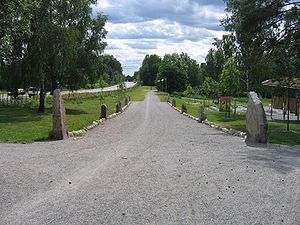
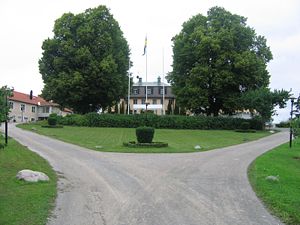
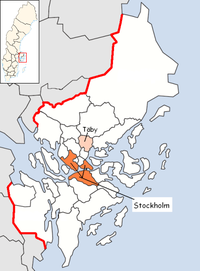
Old Norse
Old Norse is a North Germanic language that was spoken by inhabitants of Scandinavia and inhabitants of their overseas settlements during the Viking Age, until about 1300....
with the Younger Futhark
Younger Futhark
The Younger Futhark, also called Scandinavian runes, is a runic alphabet, a reduced form of the Elder Futhark, consisting of only 16 characters, in use from ca. 800 CE...
in 11th century, Uppland
Uppland
Uppland is a historical province or landskap on the eastern coast of Sweden, just north of Stockholm, the capital. It borders Södermanland, Västmanland and Gästrikland. It is also bounded by lake Mälaren and the Baltic sea...
, Sweden
Sweden
Sweden , officially the Kingdom of Sweden , is a Nordic country on the Scandinavian Peninsula in Northern Europe. Sweden borders with Norway and Finland and is connected to Denmark by a bridge-tunnel across the Öresund....
.
They were ordered in the by what appears to have been a chieftain named Jarlabanke Ingefastsson and his clan
Norse clans
The Scandinavian clan or ætt was a social group based on common descent or on the formal acceptance into the group at a þing.-History:...
(Swedish: Jarlabankeätten), in Täby
Täby
Täby is a trimunicipal locality and the seat of Täby Municipality in Stockholm County, Sweden, with 58,593 inhabitants in 2005. It is also partly located in Danderyd Municipality and Sollentuna Municipality...
. Jarlabanke was probably a hersir
Hersir
A hersir was a local military commander of a hundred and owed allegiance to a jarl or king. They were also aspiring landowners, and, like the middle class in many feudal societies, supported the kings in their centralization of power. The hersir was often equipped with a conical helmet and a short...
(chieftain of a hundred
Hundred (division)
A hundred is a geographic division formerly used in England, Wales, Denmark, South Australia, some parts of the United States, Germany , Sweden, Finland and Norway, which historically was used to divide a larger region into smaller administrative divisions...
) responsible for the local leidang
Leidang
The institution known as leiðangr , leidang , leding, , ledung , expeditio or sometimes lething , was a public levy of free farmers typical for medieval Scandinavians. It was a form of conscription to organise coastal fleets for seasonal excursions and in defence of the realm...
organization and on several runestones he stated that he was a Christian and not a Pagan
Norse paganism
Norse paganism is the religious traditions of the Norsemen, a Germanic people living in the Nordic countries. Norse paganism is therefore a subset of Germanic paganism, which was practiced in the lands inhabited by the Germanic tribes across most of Northern and Central Europe in the Viking Age...
.
Five of the runestones contain very much the same message: "Jarlabanke had these stones made after himself while he was alive. He made this bridge for his soul. He alone owned all of Täby
Täby
Täby is a trimunicipal locality and the seat of Täby Municipality in Stockholm County, Sweden, with 58,593 inhabitants in 2005. It is also partly located in Danderyd Municipality and Sollentuna Municipality...
". One stone at the church of Vallentuna also shows the following text on its second side: "Jarlabanke had this stone made after himself while he was alive. He made this assembly
Thing (assembly)
A thing was the governing assembly in Germanic and introduced into some Celtic societies, made up of the free people of the community and presided by lawspeakers, meeting in a place called a thingstead...
location and he alone owned this hundred".
The so-called Jarlabanke's bridge is a causeway in Täby which was originally bordered by four runestones and many raised stones. It is c. 116 metres long and 6.4 metres wide, and there were inscriptions (U 164 and U 165) by Jarlabanke both at the southern and the northern end of the causeway. One of the runestones was moved during his lifetime to the location of the local assembly of the Vallentuna Hundred, where it received a new text and it was replaced with a new fifth one at Jarlabanke's bridge and which had a different design.
Three other runestones present Jarlabanke as the builder of roads and bridges, and ten or so mention his family members making it possible to follow his family during four generations. His pride at building roads and bridges shows that this was something that gave prestige in 11th century Sweden.
The inscriptions have led to a controversy on the meaning of the Old Norse
Old Norse
Old Norse is a North Germanic language that was spoken by inhabitants of Scandinavia and inhabitants of their overseas settlements during the Viking Age, until about 1300....
verb eiga ("to own"), and to a debate on the origins on the hundred
Hundred (division)
A hundred is a geographic division formerly used in England, Wales, Denmark, South Australia, some parts of the United States, Germany , Sweden, Finland and Norway, which historically was used to divide a larger region into smaller administrative divisions...
division. It is debated whether he really owned the hundred or if he was appointed as its chieftain (hersir) by the King of Sweden, and a final conclusion is probably impossible to arrive at.
Omeljan Pritsak
Omeljan Pritsak
Omeljan Pritsak was the first Mykhailo Hrushevsky Professor of Ukrainian History at Harvard University and the founder and first director of the Harvard Ukrainian Research Institute.-Career:Pritsak began his academic career at the University of Lvov in interwar Poland where he...
has remarked that Jarlabanke's prominent position and property show that he and his clan profited from taking part in the Danegeld
Danegeld
The Danegeld was a tax raised to pay tribute to the Viking raiders to save a land from being ravaged. It was called the geld or gafol in eleventh-century sources; the term Danegeld did not appear until the early twelfth century...
s and from the services that men of his clan provided as mercenaries in the Varangian Guard
Varangian Guard
The Varangian Guard was an elite unit of the Byzantine Army in 10th to the 14th centuries, whose members served as personal bodyguards of the Byzantine Emperors....
and in Kievan Rus'
Kievan Rus'
Kievan Rus was a medieval polity in Eastern Europe, from the late 9th to the mid 13th century, when it disintegrated under the pressure of the Mongol invasion of 1237–1240....
.
The runestones
Besides the runestones treated in this article, there are many others that were raised by Jarlabanke and his clansmen such as U 101, U 135, U 136, U 137, U 143, U 147, U 309 and U 310. However, these runestones are treated separately as they were raised connection with EstridEstrid
Estrid was a rich and powerful 11th century Swedish woman whose long family saga has been recorded on five or six runestones in Uppland, Sweden. This Estrid was the maternal grandmother of the chieftain Jarlabanke of the Jarlabanke clan...
, the female progenitor of the Jarlabanke clan.
The remaining runestones that are associated with Jarlabanke's relatives are: U 100
Uppland Runic Inscription 100
Uppland Runic Inscription 100 is the Rundata designation for a memorial runestone that is located in the forest where a path meets a bog near Skälby, which is about two kilometers northeast of Sollentuna, Stockholm County, Sweden, which was part of the historical province of...
, U 104, U 112, U 133, U 141, U 151, U 160, U 161, U 225, U 226, U 328
Uppland Runic Inscription 328
The Uppland Runic Inscription 328 stands on a hill in a paddock at the farm Stora Lundby, which is about four kilometers west of Lindholmen, Stockholm County, Sweden, in the historic province of Uppland...
, U 336, U 343 and U 344.
U 127
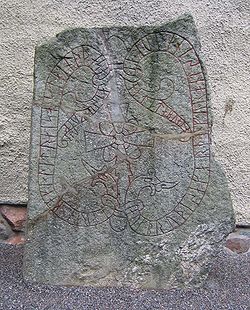
Latin transliteration:
- × iarla×baki × lit raisa [×] staina × þasa at sik × kuikuan × auk bru þisa karþi × fur ont sina × auk × ain ati tabu ala-
Old Norse transcription:
- Iarlabanki let ræisa stæina þessa at sik kvikvan, ok bro þessa gærði fyr and sina, ok æinn atti Tæby alla[n].
English translation:
- Jarlabanki had these stones raised in memory of himself while alive, and made this bridge for his spirit, and (he) alone owned all of Tábýr.
U 140
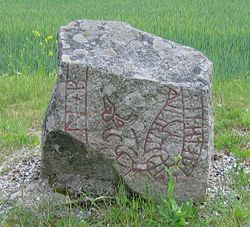
Broby bro Runestones
At Broby bro in Uppland, Sweden there are six runestones. U 139, U 140 and U 151 still stand by the road, but U 135, U 136 and U 137 have been moved a distance away from the road....
and U 150. It was discovered among the ground stones of a smaller building. It is one of two Jarlabanke runestones that mention men who travelled abroad (the other one is U 136), but it is not known who the traveller mentioned in the fragment was. It also belongs to the Greece Runestones
Greece Runestones
The Greece runestones are about 30 runestones containing information related to voyages made by Norsemen to the Eastern Roman Empire. They were made during the Viking Age until about 1100 and were engraved in the Old Norse language with Scandinavian runes...
and it is treated there as well.
Latin transliteration:
- × ...la×b(a)... ... han : entaþis * i kirikium
Old Norse transcription:
- [Iar]laba[nki] ... Hann ændaðis i Grikkium.
English translation:
- Jarlabanki ... He met his end in Greece.
U 142
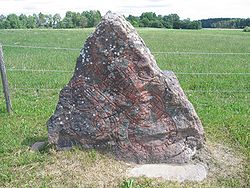
Öpir
Öpir or Öper was a runemaster who flourished during the late 11th century and early 12th century in Uppland, Sweden...
, who was the most productive runemaster
Runemaster
A runemaster or runecarver is a specialist in making runestones.Most early medieval Scandinavians were probably literate in runes, and most people probably carved messages on pieces of bone and wood. However, it was difficult to make runestones, and in order to master it one also needed to be a...
of his time.
Latin transliteration:
- ikifastr ' lit ' raisa ' stain * uk ' bro ' kera ' eftiR ' iarlabaka ' faþur ' s[in ' uk ' sun ' io]runa ' uk ' ketilau lit ' at ' bonta ' sin ybir risti
Old Norse transcription:
- Ingifastr let ræisa stæin ok bro gæra æftiR Iarlabanka, faður sinn ok sun IorunaR, ok Kætiløy let at bonda sinn. ØpiR risti.
English translation:
- Ingifastr had the stone raised and the bridge made in memory of Jarlabanki, his father, Jórunnr's son. And Ketiley had (it raised/made) in memory of her husbandman. Œpir carved.
U 148
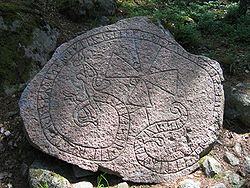
Edsviken
Edsviken is an elongated, narrow inlet of the Baltic Sea running through the Swedish municipalities of Danderyd, Solna and Sollentuna. Edsviken ranges from Stocksund and Bergshamra in the south to Edsberg in the north. The inlet is about long with an area of approximately ; its maximum depth is...
to Täby. The rune stone informs that it was raised by Ingifastr Eysteinsson (Jarlabanke's father) in memory of his wife Ragnfríðr, together with his son Hemingr (Jarlabanke's half-brother).
Latin transliteration:
- × inkifastr × lit × rista × runaR þisaR × aftiR × rahnfriþi × kuinu × sina × auk × -[m-](n)kr × aftiR × muþur × sina
Old Norse transcription:
- Ingifastr let rista runaR þessaR æftiR Ragnfriði, kvinnu sina, ok [Hæ]m[i]ngR æftiR moður sina.
English translation:
- Ingifastr had these runes carved in memory of Ragnfríðr, his wife; and Hemingr in memory of his mother.
U 149
This runestone was located in Hagby. It has, however, disappeared, but it survives in form of a drawing made by Richard DybeckRichard Dybeck
Richard Dybeck was a Swedish jurist, antiquarian and lyricist, mainly remembered as the author of the lyrics to what is now the Swedish national anthem: Du gamla, Du fria....
in 1840. The rune stone is one of those that Jarlabanke made in his own memory and it tells that was raised in connection with his constructing a path.
Latin transliteration:
- [iarlabaki × lit × -... ...tain × at * sialfan * sik * auk * braut ruþia]
Old Norse transcription:
- Iarlabanki let ... [s]tæin at sialfan sik ok braut ryðia.
English translation:
- Jarlabanki had ... the stone in memory of himself and cleared a path.
U 150

Broby bro Runestones
At Broby bro in Uppland, Sweden there are six runestones. U 139, U 140 and U 151 still stand by the road, but U 135, U 136 and U 137 have been moved a distance away from the road....
. The lower part of it has been lost, and today it is secured in the ground with a foundation of concrete. The rune stone informs that Jarlabanke and his wife Fastvé raised it in memory of their son Sveinn. The style of the stone is, however, problematic since it may be in the style of Jarlabanke's parents' generation.
Latin transliteration:
- * iarla*b]aki * auk * fastui * litu * raisa * stina * aftiR [* suain * sun * sin
Old Norse transcription:
- Iarlabanki ok Fastvi letu ræisa stæina æftiR Svæin, sun sinn.
English translation:
- Jarlabanki and Fastvé had the stones raised in memory of Sveinn, their son.
U 164
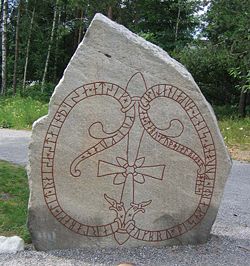
Latin transliteration:
- × iarlabaki × lit × raisa × stain × þisa × at sik × kuikuan ×× auk bru × þisa × karþi × fur ont × sina × auk ain ati × alan × tabu × kuþ hialbi ont hans
Old Norse transcription:
- Iarlabanki let ræisa stæina þessa at sik kvikvan, ok bro þessa gærði fyr and sina, ok æinn atti allan Tæby. Guð hialpi and hans.
English translation:
- Jarlabanki had these stones raised in memory of himself while alive, and made this bridge for his spirit, and (he) alone owned all of Tábýr. May God help his spirit.
U 165
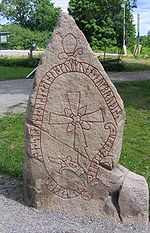
Latin transliteration:
- ia[r]labaki × li- ---sa × staina × þisa × at sik × kuikuan × auk bru þis(a) [× karþi fur ont ×] si-- --- × ati + (a)lan × tabu +
Old Norse transcription:
- Iarlabanki le[t ræi]sa stæina þessa at sik kvikvan, ok bro þessa gærði fyr and si[na ...] atti allan Tæby.
English translation:
- Jarlabanki had these stones raised in memory of himself while alive, and made this bridge for his spirit ... owned all of Tábýr.
U 212
,_vallentuna.jpg)
,_vallentuna.jpg)
Vallentuna
Vallentuna is a bimunicipal locality and the seat of Vallentuna Municipality, Stockholm County, Sweden with 26,500 inhabitants in 2005. It stretches over two municipalities in Stockholm County, in the Roslagen region. Vallentuna is also a suburb of Stockholm...
, but it is not known where its original location was. A notable aspect to the stone is the fact that it is engraved on both sides (A and B) and that the small difference between the messages is of note. On side A, he is in possession of all of Täby and here the Old Norse
Old Norse
Old Norse is a North Germanic language that was spoken by inhabitants of Scandinavia and inhabitants of their overseas settlements during the Viking Age, until about 1300....
verb eiga can be interpreted as "to own", but on side B, he was in possession of the whole hundred. In the last sense, the verb eiga probably means "to command". The latter side also informs that the rune stone was raised where he had made the assembly location of the hundred. Side B is later than side A and it was probably made after a piece of the stone had been destroyed, as is suggested by its design. Jarlabanke's power had been extended from the village of Täby to the whole hundred. Side A is in the style Pr2 (first half of the 11th century) and side B is in the style Pr2-Pr3 (mid-11th century).
Latin transliteration:
- A × iarlibaki × lit × raisa × stan + þina × a... ... ...kuan + han × ati ain × tabu × alan × -... ... ont hans +
- B × iarlabaki × lit raisa × stain × þin- at sik kuikuan × auk × þinkstaþ × þina × karþi + auk × ain ati + alt hu-(t)ari × þita +
Old Norse transcription:
- A Iarlabanki let ræisa stæin þenna a[t sik kvi]kvan. Hann atti æinn Tæby allan. [Guð hialpi] and hans.
- B Iarlabanki let ræisa stæin þenn[a] at sik kvikvan, ok þingstað þenna gærði, ok æinn atti allt hu[n]dari þetta.
English translation:
- A Jarlabanki had this stone raised in memory of himself while alive. He alone owned all of Tábýr. May God help his spirit.
- B Jarlabanki had this stone raised in memory of himself while alive, and made this Assembly-place, and alone owned all of this Hundred.
U 216
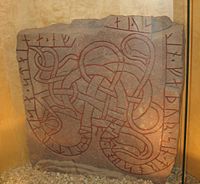
Latin transliteration:
- iuan ÷ lit ÷ raisa ' staina + ef... ' ay(s)-(a)in + faþur ' sin ÷ drosboi ÷ risti
Old Norse transcription:
- Ioan let ræisa stæina æf[tiR] Øys[t]æin, faður sinn. Drosboi risti.
English translation:
- Jóhan had the stones raised in memory of Eysteinn, his father. Drósbúi carved.
U 217
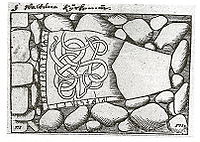
Latin transliteration:
- ikifastr lit bro kiarua iftR * s...
Old Norse transcription:
- Ingifastr let bro gærva æftiR ...
English translation:
- Ingifastr had the bridge made in memory of ...
U 261

Latin transliteration:
- iarlaba... lit × raisa × s[taina × þasa × a]t sik × kuikuan × ¶ auk × bru × þisa × karþi × fur ont [×] s[in]a × auk × ain ati alan tabu
Old Norse transcription:
- Iarlaba[nki] let ræisa stæina þessa at sik kvikvan, ok bro þessa gærði fyr and sina, ok æinn atti allan Tæby.
English translation:
- Jarlabanki had these stones raised in memory of himself while alive and made this bridge for his spirit, and (he) alone owned all of Tábýr.
Sources and external links
- Hadenius, Stig; Nilsson, Torbjörn & Åselius, Gunnar. (1996). Sveriges historia. Centraltryckeriet, Borås. ISBN 91-34-51-857-6
- Pritsak, OmeljanOmeljan PritsakOmeljan Pritsak was the first Mykhailo Hrushevsky Professor of Ukrainian History at Harvard University and the founder and first director of the Harvard Ukrainian Research Institute.-Career:Pritsak began his academic career at the University of Lvov in interwar Poland where he...
. (1981). The origin of Rus' . Cambridge, Mass.: Distributed by Harvard University Press for the Harvard Ukrainian Research Institute. ISBN 0-674-64465-4 - NationalencyklopedinNationalencyklopedinNationalencyklopedin is the most comprehensive contemporary Swedish language encyclopedia, initiated by a favourable loan from the Government of Sweden of 17 million Swedish kronor in 1980, which was repaid by December 1990...
- RundataRundataThe Scandinavian Runic-text Data Base is a project involving the creation and maintenance of a database of runic inscriptions. The project's goal is to comprehensively catalog runestones in a machine-readable way for future research...
- An English Dictionary of Runic Inscriptions of the Younger Futhark, at the university of Nottingham
- An Internet site on the Jarlabanke clan.
- A presentation at the Museum of Foteviken.
- A presentation at the National Historic Museum, in Sweden.

